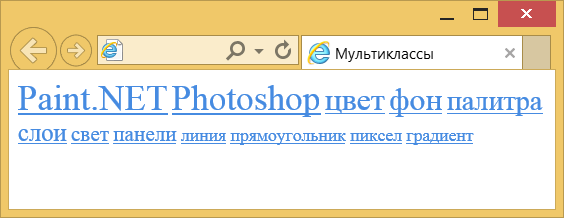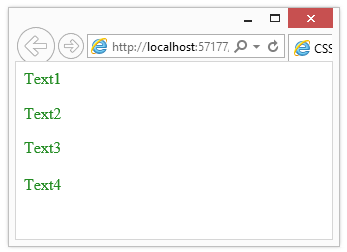Мультиклассы
К любому элементу одновременно можно добавить несколько классов, перечисляя их в атрибуте class через пробел. В этом случае к элементу применяется стиль, описанный в правилах для каждого класса. Поскольку при добавлении нескольких классов они могут содержать одинаковые стилевые свойства, но с разными значениями, то берётся значение у класса, который описан в коде ниже.
Синтаксис
Здесь E — обозначает любой элемент.
В стилях допустимо использовать запись следующего вида.
В таком случае стиль применяется только для элементов, у которых одновременно заданы классы class1 и class2 , т. е. в коде HTML используется конструкция .
Синтаксис
| Описание | Пример | |
|---|---|---|
| Указывает тип значения. | ||
| A && B | Значения должны выводиться в указанном порядке. | && |
| A | B | Указывает, что надо выбрать только одно значение из предложенных (A или B). | normal | small-caps |
| A || B | Каждое значение может использоваться самостоятельно или совместно с другими в произвольном порядке. | width || count |
| [ ] | Группирует значения. | [ crop || cross ] |
| * | Повторять ноль или больше раз. | [,]* |
| + | Повторять один или больше раз. | + |
| ? | Указанный тип, слово или группа не является обязательным. | inset? |
| Повторять не менее A, но не более B раз. | ||
| # | Повторять один или больше раз через запятую. | # |
Пример
Результат данного примера показан на рис. 1.
Рис. 1. Цвет и размер ссылок, заданный через классы
Примечание
Браузер IE до версии 7 некорректно работает с мультиклассами и понимает запись .a.b как .b , т. е. воспринимает только имя последнего класса, что приводит к ошибкам.
Спецификация
Каждая спецификация проходит несколько стадий одобрения.
- Recommendation ( Рекомендация ) — спецификация одобрена W3C и рекомендована как стандарт.
- Candidate Recommendation ( Возможная рекомендация ) — группа, отвечающая за стандарт, удовлетворена, как он соответствует своим целям, но требуется помощь сообщества разработчиков по реализации стандарта.
- Proposed Recommendation ( Предлагаемая рекомендация ) — на этом этапе документ представлен на рассмотрение Консультативного совета W3C для окончательного утверждения.
- Working Draft ( Рабочий проект ) — более зрелая версия черновика после обсуждения и внесения поправок для рассмотрения сообществом.
- Editor’s draft ( Редакторский черновик ) — черновая версия стандарта после внесения правок редакторами проекта.
- Draft ( Черновик спецификации ) — первая черновая версия стандарта.
Браузеры
В таблице браузеров применяются следующие обозначения.
- — элемент полностью поддерживается браузером;
- — элемент браузером не воспринимается и игнорируется;
- — при работе возможно появление различных ошибок, либо элемент поддерживается с оговорками.
Число указывает версию браузреа, начиная с которой элемент поддерживается.
Справочник CSS
- !important
- ::after
- ::backdrop
- ::before
- ::first-letter
- ::first-line
- ::placeholder
- ::selection
- :active
- :blank
- :checked
- :default
- :disabled
- :empty
- :enabled
- :first-child
- :first-of-type
- :focus
- :focus-within
- :fullscreen
- :hover
- :in-range
- :indeterminate
- :invalid
- :lang
- :last-child
- :last-of-type
- :link
- :not
- :nth-child
- :nth-last-child
- :nth-last-of-type
- :nth-of-type
- :only-child
- :only-of-type
- :optional
- :out-of-range
- :placeholder-shown
- :read-only
- :read-write
- :required
- :root
- :target
- :valid
- :visited
- @charset
- @document
- @font-face
- @import
- @keyframes
- @media
- @page
- @supports
- @viewport
- align-content
- align-items
- align-self
- all
- animation
- animation-delay
- animation-direction
- animation-duration
- animation-fill-mode
- animation-iteration-count
- animation-name
- animation-play-state
- animation-timing-function
- backdrop-filter
- backface-visibility
- background
- background-attachment
- background-blend-mode
- background-clip
- background-color
- background-image
- background-origin
- background-position
- background-position-x
- background-position-y
- background-repeat
- background-size
- block-size
- border
- border-bottom
- border-bottom-color
- border-bottom-left-radius
- border-bottom-right-radius
- border-bottom-style
- border-bottom-width
- border-collapse
- border-color
- border-image
- border-left
- border-left-color
- border-left-style
- border-left-width
- border-radius
- border-right
- border-right-color
- border-right-style
- border-right-width
- border-spacing
- border-style
- border-top
- border-top-color
- border-top-left-radius
- border-top-right-radius
- border-top-style
- border-top-width
- border-width
- bottom
- box-decoration-break
- box-shadow
- box-sizing
- caption-side
- caret-color
- clear
- clip
- color
- column-count
- column-fill
- column-gap
- column-rule
- column-rule-color
- column-rule-style
- column-rule-width
- column-span
- column-width
- columns
- content
- counter-increment
- counter-reset
- cursor
- direction
- display
- empty-cells
- filter
- flex
- flex-basis
- flex-direction
- flex-flow
- flex-grow
- flex-shrink
- flex-wrap
- float
- font
- font-family
- font-kerning
- font-size
- font-stretch
- font-style
- font-variant
- font-weight
- height
- hyphens
- image-rendering
- justify-content
- left
- letter-spacing
- line-clamp
- line-height
- list-style
- list-style-image
- list-style-position
- list-style-type
- margin
- margin-bottom
- margin-left
- margin-right
- margin-top
- marks
- max-height
- max-width
- min-height
- min-width
- mix-blend-mode
- object-fit
- opacity
- order
- orphans
- outline
- outline-color
- outline-offset
- outline-style
- outline-width
- overflow
- overflow-x
- overflow-y
- padding
- padding-block
- padding-block-end
- padding-block-start
- padding-bottom
- padding-inline
- padding-inline-end
- padding-inline-start
- padding-left
- padding-right
- padding-top
- page-break-after
- page-break-before
- page-break-inside
- perspective
- perspective-origin
- place-content
- pointer-events
- position
- quotes
- resize
- right
- scroll-behavior
- tab-size
- table-layout
- text-align
- text-align-last
- text-decoration
- text-decoration-color
- text-decoration-line
- text-decoration-skip-ink
- text-decoration-style
- text-emphasis
- text-emphasis-color
- text-emphasis-position
- text-emphasis-style
- text-fill-color
- text-indent
- text-orientation
- text-overflow
- text-shadow
- text-stroke
- text-stroke-color
- text-stroke-width
- text-transform
- top
- transform
- transform-origin
- transform-style
- transition
- transition-delay
- transition-duration
- transition-property
- transition-timing-function
- unicode-bidi
- user-select
- vertical-align
- visibility
- white-space
- widows
- width
- word-break
- word-spacing
- word-wrap
- writing-mode
- z-index
- zoom
Мультиклассы
К любому тегу одновременно можно добавить несколько классов, перечисляя их в атрибуте class через пробел. В этом случае к элементу применяется стиль, описанный в правилах для каждого класса. Поскольку при добавлении нескольких классов они могут содержать одинаковые стилевые свойства, но с разными значениями, то берется значение у класса, который описан в коде ниже.
Синтаксис
Здесь E — обозначает любой тег.
В стилях допустимо использовать запись следующего вида.
В таком случае стиль применяется только для элементов, у которых одновременно заданы классы class1 и class2 , т. е. в коде HTML используется конструкция .
HTML5 CSS 2.1 IE Cr Op Sa Fx
Paint.NET Photoshop цвет фон палитра слои свет панели линия прямоугольник пиксел градиент Результат данного примера показан на рис. 1.
Рис. 1. Цвет и размер ссылок, заданный через классы
Браузеры
Браузер IE до версии 7.0 некорректно работает с мультиклассами и понимает запись .a.b как .b , т.е. воспринимает только имя последнего класса, что приводит к ошибкам.
CSS по теме
Применение мультиклассов в CSS
23.10.2014
10097

Введение в мультиклассы.
В данной статье мы познакомимся с так называемыми сложными селекторами, особенностями их применения. Для более простого восприятия материала рекомендуем просмотреть пятый видео урок из курса HTML & CSS.
Для начала вспомним, что таблицы стилей собираются из наборов правил, которые содержат один или несколько селекторов и конечно же содержат блок определений. Блок определений ограничен фигурными скобками и содержит в себе перечень свойств и выбранных для них значений.
Селектором может быть любой элемент или HTML-тег, для которого возможно задание неких правил форматирования. Принцип определения селекторов довольно простой и имеет следующий синтаксис: Name < Style _ rules >.
Здесь Name – это имя любого элемента на вашей странице, а Style_rules – описание правил стиля, которые вы собираетесь применить к элементу.
Отдельно обратим ваше внимание на универсальный селектор, который используют, когда требуется установить стиль абсолютно для всех элементов, присутствующих в веб-документе. Он имеет следующий синтаксис:

/*Используем универсальный селектор, который обозначается «*» */
Multiple Class / ID and Class Selectors
They look nearly identical, but the top one has no space between #header and .callout while the bottom one does. This small difference makes a huge difference in what it does. To some of you, that top selector may seem like a mistake, but it’s actually a quite useful selector. Let’s see the difference, what that top selector means, and exploring more of that style selector. Here is the “plain English” of #header .callout :
Select all elements with the class name callout that are decendents of the element with an ID of header.
Maybe this graphic will make that more clear:
Combinations of Classes and IDs
The big point here is that you can target elements that have combinations of class es and ID s by stringing those selectors together without spaces.
Target an element that has all of multiple class es. Shown below with two class es, but not limited to two.
We aren’t limited to only two here, we can combine as many class es and ID s into a single selector as we want.
Although bear in mind that’s getting a little ridiculous. Learn more about how to select IDs, classes, and multiple classes at DigitalOcean.
So how useful is all this really? Especially with ID s, they are supposed to be unique anyway, so why would you need to combine it with a class ? I admit the use cases for the ID versions are slimmer, but there are certainly uses. One of those is overriding styles easily.
Or perhaps prefacing the selector with something even more specific. More useful is multiple class es and using them in the “object oriented” CSS style that is all the rage lately. Let’s say you had a bunch of div s on a page, and you used multiple various descriptive class names on them:
They all share the class “box”, which perhaps sets a width or a background texture, something that all of them have in common. Then some of them have color names as class es, this would be for controlling the colors used inside the box. Perhaps green means the box has a greenish background and light green text. A few of them have a class name of “border”, presumably these would have a border on them while the rest would not. So let’s set something up:
.box < width: 100px; float: left; margin: 0 10px 10px 0; >.red < color: red; background: pink; >.blue < color: blue; background: light-blue; >.green < color: green; background: light-green; >.border
Cool, we have a good toolbox going here, where we can create new boxes and we have a variety of options, we can pick a color and if it has a border or not just by applying some fairly semantic class es. Having this class name “toolbox” also allows us to target unique combinations of these class es. For example, maybe that black border isn’t working on the red boxes, let’s fix that:
Based on this demo page.
Also important to note here is that the specificity values of selectors like this will carry the same weight as if they were separate. This is what gives these the overriding power like the example above. Learn more about specificity in CSS at DigitalOcean.
All good current browsers support this as well as IE back to version 7. IE 6 is rather weird. It selects based on the last selector in the list. So “ .red.border ” will select based on just “ .border “, which kinda ruins things. But if you are supporting IE 6, you are used to this kind of tomfoolery anyway and can just fix it with conditional styles.






